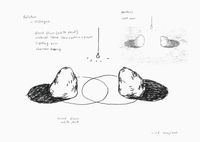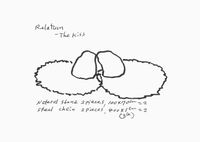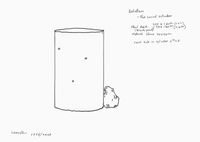


In the modern era we cannot function, as the world is haunted by the specters of 'God,' 'Man,' and now 'Information.' These ghosts shroud the whole world; the entire universe. Virtual reality cannot be made physical. It is unreachable and looks to be seen but is actually a closed world without substance or exterior. Humanity must be regenerated as one entity interacting with the external, moving beyond the ghost of the self-centered 'human,' so that to encounter that which is beyond us becomes most important. My work is extremely simple but has a unique physicality. It is neither object nor information. Rather it acts as an intermediary, an open gate, through which to see both sides. In short, my work is a place to encounter oneself and others, both the internal and the external; suggesting a new reality.– Lee Ufan1
Kukje Gallery is pleased to present a solo exhibition of Lee Ufan on view from 4 April to 28 May 2023. This is his second solo show at Kukje Gallery, following his first exhibition in 2009, and the first time in 12 years that he is showing his work in Korea, outside of Space Lee Ufan at Busan Museum of Art founded in 2015. Across the gallery's K1 space, the second floor of K2 space, and the garden, this exhibition includes six sculptures and four drawings that range from the 1980s to new works. This body of sculptures displayed in each exhibition space is an extension of Lee's 'Relatum' series that began in 1968, when he also began to take a leading role in the avant-garde movement of Mono-ha.
Rather than starting from a blank slate and creating expressions of self-representation in an objective form, Lee Ufan's works represent fragments of phenomena that interlock with reality and expressions that are open to exchange with others or the world. Although various aesthetic elements or intentions are inevitably added to the work by the artist throughout his practice, Lee endeavours to distill his ideas into the most concise and restrained forms and present them in neutral places, such as the white cube, to engage with everyday life.
Lee titles all his sculptures Relatum and often provides subtitles to hint at possible associations without giving a firm interpretation. Relatum signifies a relation that is different from the readily definable 'relationship,' but one that explores the artist's interest in how individual elements of a work are in a fluid relationship and where their context is constantly changing. In this way, the viewer, who directly intervenes in the space of the work as a relatum—along with factors such as the stone representing nature and the steel plate representing industrial society—feels a part of the conversation between the two objects or is led to reflect on the idea of co-presence by silently observing their conversation. Regarding this symbiosis, Lee has said, 'A stone is a lump of time. It is older than Earth. Steel plates are extracted from stones. In other words, the stone and the steel plate are siblings to each other. The idea of my work is to hint at the future through the encounter of a stone and a steel plate, the dialogue between nature and civilisation.' It is in light of this focus on time that Lee's work speaks to the void—defined by resonance and energy born out of collisions that manifest variability and where the inner and the outer aspects communicate.
Lee employs an anthropomorphic metaphor in Relatum – The Kiss (2023), installed in the rear gallery of the K1 space, capturing a moment of encounter. As can be inferred by its subtitle, two stones are making a point of encounter as if they are kissing, while two individual chains surrounding them overlap and cross each other, thereby creating a point of intersection. The centre of the circular chains leaning towards the position of each stone seems to emerge from the force of this encounter. As a result, the work evokes strong sense of a motion familiar from Lee's painting series From Line and From Point. Similar to this work is Relatum – Lover (1986), in which two stones seem to attempt to overcome the division in between the two disjointed steel plates and come into contact, with the aspiration to be as close to each other as possible. The gesture Lee employs in these 'Relatum' series is not only an aesthetic gesture but a factor of amplification wherein the sculpture functions as a device to awaken our sense of everyday experience by capturing a phenomenon of reality, imbued with the uncanny balance between the lifeless objects and the real-life event of the living.
Installed in the corner of the rear gallery of K1 is a series of four drawings on paper titled 'Dialogue'. Drawn using acrylic and charcoal, these works relate to Lee's iconic painting series 'Dialogue'. Each drawing appears as a sort of map depicting elements of different works; for example, the familiar stroke of paint in 'Dialogue' is here done with acrylic and charcoal and is accompanied by some stark lines. In another, Lee has drawn some stones that sit placidly on the ground surrounded by white space. Standing in front of these simple spellbinding works, the viewer feels a palpable tension, encountering deep introspection and meditation as in front of Relatum. While different and more restrained in media than the 'Dialogue' paintings, the drawing media still communicates that regardless of its form—whether it be a sculpture, drawing, steel, or a line—Lee is able to coax his viewers into a dialogue with the subject of infinity.
On the second floor of the gallery's K2 space is Relatum – The Sound Cylinder (1996/2023), consisting of a stone leaning on a hollow steel cylinder. From the five holes on the surface of the cylinder emerges the sound of the Emile Bell, also known as the Sacred Bell of Great King Seongdeok, the largest extant bronze bell in Korea, as well as nature sounds, such as birds in the woods, rain and thunder, and a mountain brook. Here, the artist once again invites the viewer to meditate on the effects aroused by the encounter of two individual objects by simply exposing the materiality of the juxtaposed natural stone and steel. Rather than making a direct interference, the 'resonance' as an effect generated by such an encounter, corresponds to the nature of sound in that both forms of resonance are invisible. Playing on the medium of air, this work evokes how two distinct forms of resonance can form a relatum.
Installed on the same floor of the K2 space is Relatum – Seem (2009), which is composed of a stone facing an empty canvas. The empty canvas evokes minimalist predecessors such as White Painting (1951) by Robert Rauschenberg or the work 4'33" (1952) by John Cage. However, Lee's empty canvas deliberately vacates any remark of statements that challenges the binary distinctions between music and non-music, or painting and non-painting, as explored in those works previously mentioned. Instead, the white canvas and the dimly lit stone standing in front simply remain silent and open, reminiscent of deep meditation that invites the viewer to join the foreign yet productive dialogue. In so doing, the work becomes a condensed version of a space where complex layers of interactions unfold symbiotically within the presence of the viewer.
With a profound reflection on infinity embodied in every work, this exhibition invites the viewer to experience the grand narrative and theory that underlie the lifelong practice of Lee Ufan.
Press release courtesy Kukje Gallery.
K1, K2 2F, K2 garden
54, Samcheong-ro
Jongno-gu
Seoul, 03053
South Korea
www.kukjegallery.com
+82 2 735 8449
+82 2 733 4879 (Fax)
Monday – Saturday
10am – 6pm
Sunnday
10am – 5pm
National Holidays
10am – 5pm
Summer Holiday
5 – 15 August 2023